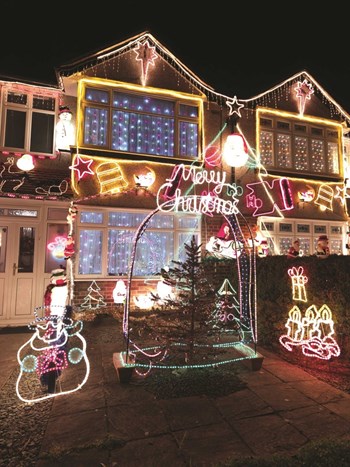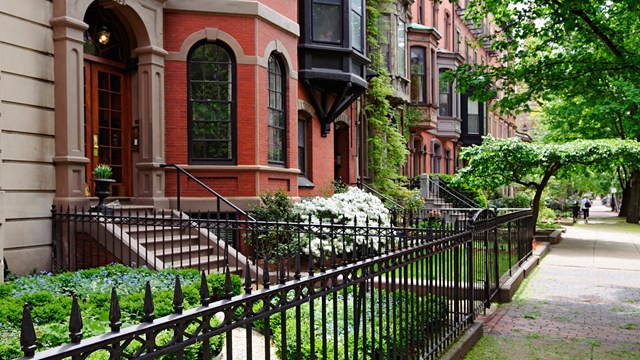
Holiday decorations are a bit like art—you know what you like when you see it. And our own sense of neighborliness and desire to live in a friendly community, combined with our need to respect freedom of expression, mean we must recognize each other’s rights when it comes to decorating for the holidays.
But with many traditions of faith converging in the collection of households that comprise a condominium community, some practices that are routine for those of one tradition might be deemed beyond the scope of allowable holiday decoration by the majority of residents in that community. And that can be OK, too, since a condominium community is really more like a corporation than it is a mini-democracy. Even so, we are living in a democracy and are subject to its laws.
Many associations regulate decorations of individual residences, but experts say the best practices for such regulations should strive to treat all residents equally. In matters of taste or belief, though, a blessing to one person can be a pox to another. So, how a board ensures that decorations are done in a reasonable way and are not over-done, could help to define the atmosphere of the community. Enforcing holiday decoration restrictions that are seemingly biased could result in lawsuits, which could cost thousands in lawyers’ fees and take years to settle.
While much of this area can be tactfully and equitably governed by an association, board members should remember to speak with their experts: their property management team and the building’s attorney. They will understand the case law behind the rulings, and will readily see the nuances in restrictive wording that might be seen as biased. With the right direction from experts and a fair-minded approach, a community’s restrictions on decorations will be respected and appreciated for clarifying the lines of a very gray area.
Regulating Fairly
Some communities take a hands-off approach when considering decorations that residents put up during the fall and winter holidays. Associations that have regulations regarding exterior decorations of residences sometimes disregard their own rules during the holidays, says attorney Stephen Marcus, a partner with the Braintree, Massachusetts-based law firm of Marcus, Errico, Emmer & Brooks. Associations with such restrictions are free to suspend or bend the rules from Thanksgiving through New Year’s and many do, he says.
When an association does choose to have and/or enforce restrictions on holiday decorations, those regulations should never be specific to any particular holiday, because doing so could get the community in conflict with residents’ first amendment rights, says Frank Flynn, managing partner of Boston-based law firm Downing & Flynn.
Marcus agrees with the rule of thumb. “We don’t dictate the content [of the decorations]. There’s nothing wrong with saying, only 10 feet of lights, or a sign that’s no more than 2 feet by 3 feet, for example,” he says.
Restrictions that pertain to individual units should be included in the condominium trust bylaws, legal experts say. This is needed for the regulations to legally restrict the use of the unit.
Restrictions on decorations cannot be selective, and must apply to everyone in the community, otherwise an association might open itself up to claims of discrimination. In the case of Franklin v. Spadafora, unit owners had notice by the association that they couldn’t put up signs on their units. The court found the rule wasn’t a violation because it was a part of the bylaws, which all owners of the community were aware of prior to buying there.
The decision was similar to the Massachusetts Superior Court ruling in the case of Devine v. Fischer. In that case, the court ruled against residents placing signs on the balconies and porches of units, because the restrictions against signs were detailed in the community’s bylaws.
“If a condo wants to restrict decorations, they need to have an across-the-board restriction that restricts all decorations,” Flynn says. “There’s no guarantee that there won’t be a court challenge. Having such a restriction in the bylaws does not make you litigation-proof.”
Holiday decoration restrictions should apply to everyone in the community, and not favor any one religion. Failing to practice such impartiality could cost all the residents money. In one court case, a resident erected a Sukkah in a common area, in commemoration of the Jewish holiday of Sukkot, which commemorates the 40-year wandering of the Jewish people in the desert. Though the resident put up the tent-like structure in a common area, as dictated by his religion, he was living in the shelter during the holiday.
The community’s association told the resident to take the structure down, but he refused and the matter went into litigation. The court ruled that though the structure was in violation of the community’s rules, the resident was allowed to keep it up for the rest of the holiday season, after which enforcement of the community’s regulation would take effect.
In another case a decade ago, a North Shore Boston condominium association’s leaders had read about the incidence of Christmas trees and fires, and banned Christmas trees as a precaution. The board had intended to help keep residents safe with the prohibition, but the move backfired, since many in the community wanted Christmas trees and followed the tradition. Ultimately the board had to rescind the policy, and suffered a black eye in the process.
“It became a public relations nightmare. They got totally beaten up in the press,” Marcus says.
Scott J. Sandler, an attorney with the law firm of Perlstein, Sandler & McCracken, in Farmington, Connecticut, says having rules regarding decorations can be rough territory to navigate. “It’s very difficult, because one man’s art is another man’s trash. With holiday decorations, you want to allow for a reasonable amount of tasteful expression, while maintaining control over the manner of expression,” he says.
That’s why many associations have rules that govern the size of a holiday display, as well as where it might be placed on the exterior of a unit. Such rules also often restrict when the display can be put up and when it must be taken down.
This rule-making is a fine line, since the best course is to give people the right to express themselves without infringing upon anyone else’s rights. Arguments can be made for and against holiday decorations, including that they brighten up a community in the colder months, or that their appearance lowers property values. Some of these perspectives are entirely valid, when they are referring to space that is community property. But with individual residences, black and white rules don’t apply.
Avoiding Trouble
America is a nation of diversity, with people of many faiths, and many people who follow no religion. While some might not like the sight of the decorations of another person’s religion and other residents would prefer to see no decorations at all, tolerance should be a guiding perspective during the holidays, legal experts say. Simply not liking to have to look at a holiday display isn’t reason enough to prohibit such a display.
“The answer to someone who doesn’t want to see some holiday decorations is that there’s a time when you have to let it go,” Marcus says. “There are board members who say the building’s documents say this, and it should be enforced. Your documents also give you the right to relax the rules.”
Each community is different, and depending upon its needs, a community might regulate decorations strictly or not at all. But where these strictures are in place, their wording must be precise, and their enforcement must be uniformly applied. Ignorance of the significance of another resident’s religious beliefs is no excuse for restricting the expression of those beliefs.
“It depends upon the community. The association needs to take into account what kind of community it is,” Sandler says. In some communities, the board may want to allow candles in windows and door wreaths, he says.
Similarly, regulations on the decoration of apartment doors, or on the placement or prohibition of lawn ornaments, should take into account the character of the community. For board members and others, knowing a community can sometimes mean working to understand the beliefs of others in the community. Failing in this duty could be unwittingly offensive.
In one case, an association told a Jewish family to take down a mezuzah it had placed in its doorway. A mezuzah is a small metal box, a few inches long, inside of which is a prayer scroll from the Torah, which serves as a blessing on the home. The association board dealt with the matter by enforcing its total prohibition on such decorations, but it had to go back on that action.
Because mezuzahs are not holiday-specific, and are placed on the door permanently, it no doubt seemed to some that the association had a right to refuse to allow it. But since the decoration is a display of one’s faith, it is protected under our laws. Mezuzahs, in some ways, are similar to the small metal or wooden crosses that some Christians hang on their front doors. Recognizing the similarity, some associations have regulations that allow for such year-round decorations, provided they are within certain size limitations.
Jonathan Barnes is a freelance writer who regularly contributes to New England Condominium and other publications.





Leave a Comment